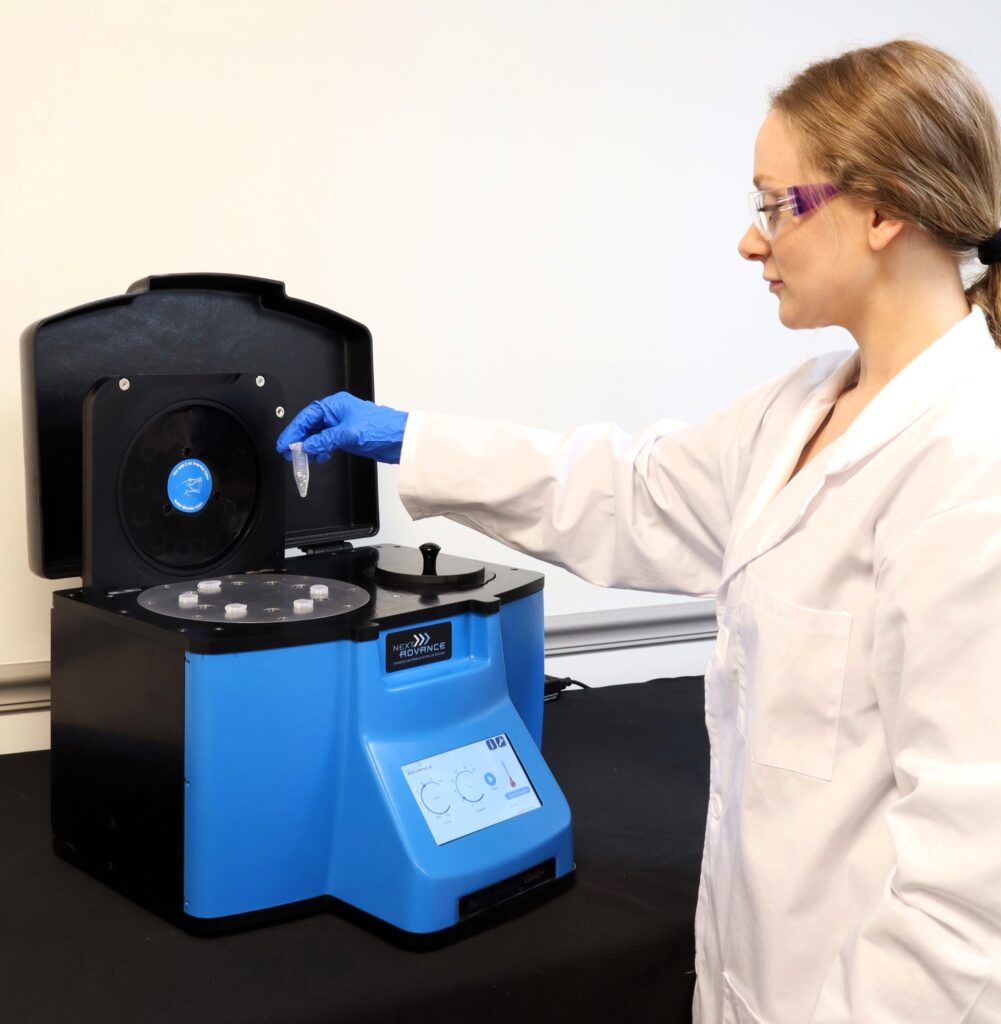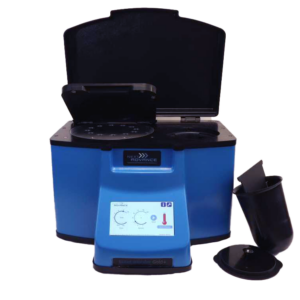Ideal for Colon Tissue Homogenization
Do you spend lots of time and effort homogenizing colon tissue samples? The Bullet Blender® tissue homogenizer delivers high quality and superior yields. No other homogenizer comes close to delivering the Bullet Blender’s winning combination of top-quality performance and budget-friendly affordability.
Save Time, Effort and Get Superior Results with
The Bullet Blender Homogenizer
Consistent and High Yield Results
Run up to 24 samples at the same time under microprocessor-controlled conditions, ensuring experimental reproducibility and high yield. Process samples from 10mg or less up to 3.5g.No Cross Contamination
No part of the Bullet Blender ever touches the tissue – the sample tubes are kept closed during homogenization. There are no probes to clean between samples.Samples Stay Cool
The Bullet Blenders’ innovative and elegant design provides convective cooling of the samples, so they do not heat up more than several degrees. In fact, our Gold+ models hold the sample temperature to about 4ºC.Easy and Convenient to Use
Just place beads and buffer along with your tissue sample in standard tubes, load tubes directly in the Bullet Blender, select time and speed, and press start.Risk Free Purchase
Thousands of peer-reviewed journal articles attest to the consistency and quality of the Bullet Blender homogenizer. We offer a 2 year warranty, extendable to 4 years, because our Bullet Blenders are reliable and last for many years.Intestine Homogenization Protocol
| Sample Tube | Protocol |
|---|---|
| 1.5 mL tubes | 1.5 mL tubes Intestine Protocol |
| 1.5/2 mL tubes in 5 mL adapters | 1.5/2 mL tubes in 5 mL adapters Intestine Protocol |
| 5 mL tubes | 5 mL tubes Intestine Protocol |
What Else Can You Homogenize? Tough or Soft, No Problem!
The Bullet Blender can process a wide range of samples including organ tissue, cell culture, plant tissue, and small organisms. You can homogenize samples as tough as mouse femur or for gentle applications such as tissue dissociation or organelle isolation.

Want more guidance? Need a quote? Contact us:

Bullet Blender Models
Select Publications using the Bullet Blender to Homogenize Colon Tissue
2474232
colon
1
apa
50
date
desc
3134
https://www.nextadvance.com/wp-content/plugins/zotpress/
%7B%22status%22%3A%22success%22%2C%22updateneeded%22%3Afalse%2C%22instance%22%3Afalse%2C%22meta%22%3A%7B%22request_last%22%3A0%2C%22request_next%22%3A0%2C%22used_cache%22%3Atrue%7D%2C%22data%22%3A%5B%7B%22key%22%3A%22EJRF7M2Z%22%2C%22library%22%3A%7B%22id%22%3A2474232%7D%2C%22meta%22%3A%7B%22creatorSummary%22%3A%22Nam%20et%20al.%22%2C%22parsedDate%22%3A%222015-08-06%22%2C%22numChildren%22%3A0%7D%2C%22bib%22%3A%22%26lt%3Bdiv%20class%3D%26quot%3Bcsl-bib-body%26quot%3B%20style%3D%26quot%3Bline-height%3A%202%3B%20padding-left%3A%201em%3B%20text-indent%3A-1em%3B%26quot%3B%26gt%3B%5Cn%20%20%26lt%3Bdiv%20class%3D%26quot%3Bcsl-entry%26quot%3B%26gt%3BNam%2C%20S.%20H.%2C%20Kim%2C%20D.%2C%20Lee%2C%20M.-S.%2C%20Lee%2C%20D.%2C%20Kwak%2C%20T.%20K.%2C%20Kang%2C%20M.%2C%20Ryu%2C%20J.%2C%20Kim%2C%20H.-J.%2C%20Song%2C%20H.%20E.%2C%20Choi%2C%20J.%2C%20Lee%2C%20G.-H.%2C%20Kim%2C%20S.-Y.%2C%20Park%2C%20S.%20H.%2C%20Kim%2C%20D.%20G.%2C%20Kwon%2C%20N.%20H.%2C%20Kim%2C%20T.%20Y.%2C%20Thiery%2C%20J.%20P.%2C%20Kim%2C%20S.%2C%20%26amp%3B%20Lee%2C%20J.%20W.%20%282015%29.%20Noncanonical%20roles%20of%20membranous%20lysyl-tRNA%20synthetase%20in%20transducing%20cell-substrate%20signaling%20for%20invasive%20dissemination%20of%20colon%20cancer%20spheroids%20in%203D%20collagen%20I%20gels.%20%26lt%3Bi%26gt%3BOncotarget%26lt%3B%5C%2Fi%26gt%3B%2C%20%26lt%3Bi%26gt%3B6%26lt%3B%5C%2Fi%26gt%3B%2825%29%2C%2021655%26%23x2013%3B21674.%20%26lt%3Ba%20class%3D%26%23039%3Bzp-DOIURL%26%23039%3B%20href%3D%26%23039%3Bhttps%3A%5C%2F%5C%2Fdoi.org%5C%2F10.18632%5C%2Foncotarget.4130%26%23039%3B%26gt%3Bhttps%3A%5C%2F%5C%2Fdoi.org%5C%2F10.18632%5C%2Foncotarget.4130%26lt%3B%5C%2Fa%26gt%3B%26lt%3B%5C%2Fdiv%26gt%3B%5Cn%26lt%3B%5C%2Fdiv%26gt%3B%22%2C%22data%22%3A%7B%22itemType%22%3A%22journalArticle%22%2C%22title%22%3A%22Noncanonical%20roles%20of%20membranous%20lysyl-tRNA%20synthetase%20in%20transducing%20cell-substrate%20signaling%20for%20invasive%20dissemination%20of%20colon%20cancer%20spheroids%20in%203D%20collagen%20I%20gels%22%2C%22creators%22%3A%5B%7B%22creatorType%22%3A%22author%22%2C%22firstName%22%3A%22Seo%20Hee%22%2C%22lastName%22%3A%22Nam%22%7D%2C%7B%22creatorType%22%3A%22author%22%2C%22firstName%22%3A%22Doyeun%22%2C%22lastName%22%3A%22Kim%22%7D%2C%7B%22creatorType%22%3A%22author%22%2C%22firstName%22%3A%22Mi-Sook%22%2C%22lastName%22%3A%22Lee%22%7D%2C%7B%22creatorType%22%3A%22author%22%2C%22firstName%22%3A%22Doohyung%22%2C%22lastName%22%3A%22Lee%22%7D%2C%7B%22creatorType%22%3A%22author%22%2C%22firstName%22%3A%22Tae%20Kyoung%22%2C%22lastName%22%3A%22Kwak%22%7D%2C%7B%22creatorType%22%3A%22author%22%2C%22firstName%22%3A%22Minkyung%22%2C%22lastName%22%3A%22Kang%22%7D%2C%7B%22creatorType%22%3A%22author%22%2C%22firstName%22%3A%22Jihye%22%2C%22lastName%22%3A%22Ryu%22%7D%2C%7B%22creatorType%22%3A%22author%22%2C%22firstName%22%3A%22Hye-Jin%22%2C%22lastName%22%3A%22Kim%22%7D%2C%7B%22creatorType%22%3A%22author%22%2C%22firstName%22%3A%22Haeng%20Eun%22%2C%22lastName%22%3A%22Song%22%7D%2C%7B%22creatorType%22%3A%22author%22%2C%22firstName%22%3A%22Jungeun%22%2C%22lastName%22%3A%22Choi%22%7D%2C%7B%22creatorType%22%3A%22author%22%2C%22firstName%22%3A%22Gyu-Ho%22%2C%22lastName%22%3A%22Lee%22%7D%2C%7B%22creatorType%22%3A%22author%22%2C%22firstName%22%3A%22Sang-Yeob%22%2C%22lastName%22%3A%22Kim%22%7D%2C%7B%22creatorType%22%3A%22author%22%2C%22firstName%22%3A%22Song%20Hwa%22%2C%22lastName%22%3A%22Park%22%7D%2C%7B%22creatorType%22%3A%22author%22%2C%22firstName%22%3A%22Dae%20Gyu%22%2C%22lastName%22%3A%22Kim%22%7D%2C%7B%22creatorType%22%3A%22author%22%2C%22firstName%22%3A%22Nam%20Hoon%22%2C%22lastName%22%3A%22Kwon%22%7D%2C%7B%22creatorType%22%3A%22author%22%2C%22firstName%22%3A%22Tai%20Young%22%2C%22lastName%22%3A%22Kim%22%7D%2C%7B%22creatorType%22%3A%22author%22%2C%22firstName%22%3A%22Jean%20Paul%22%2C%22lastName%22%3A%22Thiery%22%7D%2C%7B%22creatorType%22%3A%22author%22%2C%22firstName%22%3A%22Sunghoon%22%2C%22lastName%22%3A%22Kim%22%7D%2C%7B%22creatorType%22%3A%22author%22%2C%22firstName%22%3A%22Jung%20Weon%22%2C%22lastName%22%3A%22Lee%22%7D%5D%2C%22abstractNote%22%3A%22%22%2C%22date%22%3A%222015-8-6%22%2C%22language%22%3A%22en%22%2C%22DOI%22%3A%2210.18632%5C%2Foncotarget.4130%22%2C%22ISSN%22%3A%221949-2553%22%2C%22url%22%3A%22http%3A%5C%2F%5C%2Foncotarget.com%5C%2Fabstract%5C%2F4130%22%2C%22collections%22%3A%5B%22M2MNG549%22%5D%2C%22dateModified%22%3A%222015-12-31T22%3A00%3A32Z%22%7D%7D%2C%7B%22key%22%3A%22X6SMNSAJ%22%2C%22library%22%3A%7B%22id%22%3A2474232%7D%2C%22meta%22%3A%7B%22creatorSummary%22%3A%22Goodrich%20et%20al.%22%2C%22parsedDate%22%3A%222015%22%2C%22numChildren%22%3A0%7D%2C%22bib%22%3A%22%26lt%3Bdiv%20class%3D%26quot%3Bcsl-bib-body%26quot%3B%20style%3D%26quot%3Bline-height%3A%202%3B%20padding-left%3A%201em%3B%20text-indent%3A-1em%3B%26quot%3B%26gt%3B%5Cn%20%20%26lt%3Bdiv%20class%3D%26quot%3Bcsl-entry%26quot%3B%26gt%3BGoodrich%2C%20K.%20M.%2C%20Smithson%2C%20A.%20T.%2C%20Ickes%2C%20A.%20K.%2C%20%26amp%3B%20Neilson%2C%20A.%20P.%20%282015%29.%20Pan-colonic%20pharmacokinetics%20of%20catechins%20and%20procyanidins%20in%20male%20Sprague%26%23x2013%3BDawley%20rats.%20%26lt%3Bi%26gt%3BThe%20Journal%20of%20Nutritional%20Biochemistry%26lt%3B%5C%2Fi%26gt%3B.%20%26lt%3Ba%20class%3D%26%23039%3Bzp-DOIURL%26%23039%3B%20href%3D%26%23039%3Bhttps%3A%5C%2F%5C%2Fdoi.org%5C%2F10.1016%5C%2Fj.jnutbio.2015.04.008%26%23039%3B%26gt%3Bhttps%3A%5C%2F%5C%2Fdoi.org%5C%2F10.1016%5C%2Fj.jnutbio.2015.04.008%26lt%3B%5C%2Fa%26gt%3B%26lt%3B%5C%2Fdiv%26gt%3B%5Cn%26lt%3B%5C%2Fdiv%26gt%3B%22%2C%22data%22%3A%7B%22itemType%22%3A%22journalArticle%22%2C%22title%22%3A%22Pan-colonic%20pharmacokinetics%20of%20catechins%20and%20procyanidins%20in%20male%20Sprague%5Cu2013Dawley%20rats%22%2C%22creators%22%3A%5B%7B%22creatorType%22%3A%22author%22%2C%22firstName%22%3A%22Katheryn%20M.%22%2C%22lastName%22%3A%22Goodrich%22%7D%2C%7B%22creatorType%22%3A%22author%22%2C%22firstName%22%3A%22Andrew%20T.%22%2C%22lastName%22%3A%22Smithson%22%7D%2C%7B%22creatorType%22%3A%22author%22%2C%22firstName%22%3A%22Anne%20K.%22%2C%22lastName%22%3A%22Ickes%22%7D%2C%7B%22creatorType%22%3A%22author%22%2C%22firstName%22%3A%22Andrew%20P.%22%2C%22lastName%22%3A%22Neilson%22%7D%5D%2C%22abstractNote%22%3A%22%22%2C%22date%22%3A%225%5C%2F2015%22%2C%22language%22%3A%22en%22%2C%22DOI%22%3A%2210.1016%5C%2Fj.jnutbio.2015.04.008%22%2C%22ISSN%22%3A%2209552863%22%2C%22url%22%3A%22http%3A%5C%2F%5C%2Flinkinghub.elsevier.com%5C%2Fretrieve%5C%2Fpii%5C%2FS0955286315001072%22%2C%22collections%22%3A%5B%22M2MNG549%22%5D%2C%22dateModified%22%3A%222015-07-31T17%3A38%3A34Z%22%7D%7D%2C%7B%22key%22%3A%22X4FJ9MVP%22%2C%22library%22%3A%7B%22id%22%3A2474232%7D%2C%22meta%22%3A%7B%22creatorSummary%22%3A%22Nugent%20et%20al.%22%2C%22parsedDate%22%3A%222014-04-04%22%2C%22numChildren%22%3A0%7D%2C%22bib%22%3A%22%26lt%3Bdiv%20class%3D%26quot%3Bcsl-bib-body%26quot%3B%20style%3D%26quot%3Bline-height%3A%202%3B%20padding-left%3A%201em%3B%20text-indent%3A-1em%3B%26quot%3B%26gt%3B%5Cn%20%20%26lt%3Bdiv%20class%3D%26quot%3Bcsl-entry%26quot%3B%26gt%3BNugent%2C%20J.%20L.%2C%20McCoy%2C%20A.%20N.%2C%20Addamo%2C%20C.%20J.%2C%20Jia%2C%20W.%2C%20Sandler%2C%20R.%20S.%2C%20%26amp%3B%20Keku%2C%20T.%20O.%20%282014%29.%20Altered%20Tissue%20Metabolites%20Correlate%20with%20Microbial%20Dysbiosis%20in%20Colorectal%20Adenomas.%20%26lt%3Bi%26gt%3BJournal%20of%20Proteome%20Research%26lt%3B%5C%2Fi%26gt%3B%2C%20%26lt%3Bi%26gt%3B13%26lt%3B%5C%2Fi%26gt%3B%284%29%2C%201921%26%23x2013%3B1929.%20%26lt%3Ba%20class%3D%26%23039%3Bzp-DOIURL%26%23039%3B%20href%3D%26%23039%3Bhttps%3A%5C%2F%5C%2Fdoi.org%5C%2F10.1021%5C%2Fpr4009783%26%23039%3B%26gt%3Bhttps%3A%5C%2F%5C%2Fdoi.org%5C%2F10.1021%5C%2Fpr4009783%26lt%3B%5C%2Fa%26gt%3B%26lt%3B%5C%2Fdiv%26gt%3B%5Cn%26lt%3B%5C%2Fdiv%26gt%3B%22%2C%22data%22%3A%7B%22itemType%22%3A%22journalArticle%22%2C%22title%22%3A%22Altered%20Tissue%20Metabolites%20Correlate%20with%20Microbial%20Dysbiosis%20in%20Colorectal%20Adenomas%22%2C%22creators%22%3A%5B%7B%22creatorType%22%3A%22author%22%2C%22firstName%22%3A%22Julia%20L.%22%2C%22lastName%22%3A%22Nugent%22%7D%2C%7B%22creatorType%22%3A%22author%22%2C%22firstName%22%3A%22Amber%20N.%22%2C%22lastName%22%3A%22McCoy%22%7D%2C%7B%22creatorType%22%3A%22author%22%2C%22firstName%22%3A%22Cassandra%20J.%22%2C%22lastName%22%3A%22Addamo%22%7D%2C%7B%22creatorType%22%3A%22author%22%2C%22firstName%22%3A%22Wei%22%2C%22lastName%22%3A%22Jia%22%7D%2C%7B%22creatorType%22%3A%22author%22%2C%22firstName%22%3A%22Robert%20S.%22%2C%22lastName%22%3A%22Sandler%22%7D%2C%7B%22creatorType%22%3A%22author%22%2C%22firstName%22%3A%22Temitope%20O.%22%2C%22lastName%22%3A%22Keku%22%7D%5D%2C%22abstractNote%22%3A%22%22%2C%22date%22%3A%222014-04-04%22%2C%22language%22%3A%22en%22%2C%22DOI%22%3A%2210.1021%5C%2Fpr4009783%22%2C%22ISSN%22%3A%221535-3893%2C%201535-3907%22%2C%22url%22%3A%22http%3A%5C%2F%5C%2Fpubs.acs.org%5C%2Fdoi%5C%2Fabs%5C%2F10.1021%5C%2Fpr4009783%22%2C%22collections%22%3A%5B%22M2MNG549%22%5D%2C%22dateModified%22%3A%222015-08-18T17%3A40%3A22Z%22%7D%7D%2C%7B%22key%22%3A%222U9W7N8X%22%2C%22library%22%3A%7B%22id%22%3A2474232%7D%2C%22meta%22%3A%7B%22creatorSummary%22%3A%22Penney%20et%20al.%22%2C%22parsedDate%22%3A%222014%22%2C%22numChildren%22%3A0%7D%2C%22bib%22%3A%22%26lt%3Bdiv%20class%3D%26quot%3Bcsl-bib-body%26quot%3B%20style%3D%26quot%3Bline-height%3A%202%3B%20padding-left%3A%201em%3B%20text-indent%3A-1em%3B%26quot%3B%26gt%3B%5Cn%20%20%26lt%3Bdiv%20class%3D%26quot%3Bcsl-entry%26quot%3B%26gt%3BPenney%2C%20R.%2C%20Lundgreen%2C%20A.%2C%20Yao-Borengasser%2C%20A.%2C%20Edavana%2C%20V.%2C%20Williams%2C%20S.%2C%20Dhakal%2C%20I.%2C%20Wolff%2C%20R.%2C%20Kadlubar%2C%20S.%2C%20%26amp%3B%20Slattery%2C%20M.%20%282014%29.%20CYP19A1%20single%20nucleotide%20polymorphism%20associations%20with%20CYP19A1%2C%20NF%26amp%3Bamp%3Bkappa%3BB1%2C%20and%20IL6%20gene%20expression%20in%20human%20normal%20colon%20and%20normal%20liver%20samples.%20%26lt%3Bi%26gt%3BPharmacogenomics%20and%20Personalized%20Medicine%26lt%3B%5C%2Fi%26gt%3B%2C%20163.%20%26lt%3Ba%20class%3D%26%23039%3Bzp-DOIURL%26%23039%3B%20href%3D%26%23039%3Bhttps%3A%5C%2F%5C%2Fdoi.org%5C%2F10.2147%5C%2FPGPM.S62238%26%23039%3B%26gt%3Bhttps%3A%5C%2F%5C%2Fdoi.org%5C%2F10.2147%5C%2FPGPM.S62238%26lt%3B%5C%2Fa%26gt%3B%26lt%3B%5C%2Fdiv%26gt%3B%5Cn%26lt%3B%5C%2Fdiv%26gt%3B%22%2C%22data%22%3A%7B%22itemType%22%3A%22journalArticle%22%2C%22title%22%3A%22CYP19A1%20single%20nucleotide%20polymorphism%20associations%20with%20CYP19A1%2C%20NF%26amp%3Bkappa%3BB1%2C%20and%20IL6%20gene%20expression%20in%20human%20normal%20colon%20and%20normal%20liver%20samples%22%2C%22creators%22%3A%5B%7B%22creatorType%22%3A%22author%22%2C%22firstName%22%3A%22Rosalind%22%2C%22lastName%22%3A%22Penney%22%7D%2C%7B%22creatorType%22%3A%22author%22%2C%22firstName%22%3A%22Abbie%22%2C%22lastName%22%3A%22Lundgreen%22%7D%2C%7B%22creatorType%22%3A%22author%22%2C%22firstName%22%3A%22Aiwei%22%2C%22lastName%22%3A%22Yao-Borengasser%22%7D%2C%7B%22creatorType%22%3A%22author%22%2C%22firstName%22%3A%22Vineetha%22%2C%22lastName%22%3A%22Edavana%22%7D%2C%7B%22creatorType%22%3A%22author%22%2C%22firstName%22%3A%22Suzanne%22%2C%22lastName%22%3A%22Williams%22%7D%2C%7B%22creatorType%22%3A%22author%22%2C%22firstName%22%3A%22Ishwori%22%2C%22lastName%22%3A%22Dhakal%22%7D%2C%7B%22creatorType%22%3A%22author%22%2C%22firstName%22%3A%22Roger%22%2C%22lastName%22%3A%22Wolff%22%7D%2C%7B%22creatorType%22%3A%22author%22%2C%22firstName%22%3A%22Susan%22%2C%22lastName%22%3A%22Kadlubar%22%7D%2C%7B%22creatorType%22%3A%22author%22%2C%22firstName%22%3A%22Martha%22%2C%22lastName%22%3A%22Slattery%22%7D%5D%2C%22abstractNote%22%3A%22%22%2C%22date%22%3A%2207%5C%2F2014%22%2C%22language%22%3A%22en%22%2C%22DOI%22%3A%2210.2147%5C%2FPGPM.S62238%22%2C%22ISSN%22%3A%221178-7066%22%2C%22url%22%3A%22http%3A%5C%2F%5C%2Fwww.dovepress.com%5C%2Fcyp19a1-single-nucleotide-polymorphism-associations-with-cyp19a1-nfkap-peer-reviewed-article-PGPM%22%2C%22collections%22%3A%5B%22M2MNG549%22%5D%2C%22dateModified%22%3A%222015-09-02T19%3A30%3A59Z%22%7D%7D%2C%7B%22key%22%3A%22JA8BHEJV%22%2C%22library%22%3A%7B%22id%22%3A2474232%7D%2C%22meta%22%3A%7B%22creatorSummary%22%3A%22Slattery%20et%20al.%22%2C%22parsedDate%22%3A%222014%22%2C%22numChildren%22%3A0%7D%2C%22bib%22%3A%22%26lt%3Bdiv%20class%3D%26quot%3Bcsl-bib-body%26quot%3B%20style%3D%26quot%3Bline-height%3A%202%3B%20padding-left%3A%201em%3B%20text-indent%3A-1em%3B%26quot%3B%26gt%3B%5Cn%20%20%26lt%3Bdiv%20class%3D%26quot%3Bcsl-entry%26quot%3B%26gt%3BSlattery%2C%20M.%20L.%2C%20Lundgreen%2C%20A.%2C%20Mullany%2C%20L.%20E.%2C%20Penney%2C%20R.%20B.%2C%20%26amp%3B%20Wolff%2C%20R.%20K.%20%282014%29.%20Influence%20of%20CHIEF%20pathway%20genes%20on%20gene%20expression%3A%20a%20pathway%20approach%20to%20functionality.%20%26lt%3Bi%26gt%3BInternational%20Journal%20of%20Molecular%20Epidemiology%20and%20Genetics%26lt%3B%5C%2Fi%26gt%3B%2C%20%26lt%3Bi%26gt%3B5%26lt%3B%5C%2Fi%26gt%3B%282%29%2C%20100%26%23x2013%3B111.%26lt%3B%5C%2Fdiv%26gt%3B%5Cn%26lt%3B%5C%2Fdiv%26gt%3B%22%2C%22data%22%3A%7B%22itemType%22%3A%22journalArticle%22%2C%22title%22%3A%22Influence%20of%20CHIEF%20pathway%20genes%20on%20gene%20expression%3A%20a%20pathway%20approach%20to%20functionality%22%2C%22creators%22%3A%5B%7B%22creatorType%22%3A%22author%22%2C%22firstName%22%3A%22Martha%20L.%22%2C%22lastName%22%3A%22Slattery%22%7D%2C%7B%22creatorType%22%3A%22author%22%2C%22firstName%22%3A%22Abbie%22%2C%22lastName%22%3A%22Lundgreen%22%7D%2C%7B%22creatorType%22%3A%22author%22%2C%22firstName%22%3A%22Lila%20E.%22%2C%22lastName%22%3A%22Mullany%22%7D%2C%7B%22creatorType%22%3A%22author%22%2C%22firstName%22%3A%22Rosalind%20B.%22%2C%22lastName%22%3A%22Penney%22%7D%2C%7B%22creatorType%22%3A%22author%22%2C%22firstName%22%3A%22Roger%20K.%22%2C%22lastName%22%3A%22Wolff%22%7D%5D%2C%22abstractNote%22%3A%22BACKGROUND%3A%20Candidate%20pathway%20approaches%20in%20disease%20association%20studies%20often%20utilize%20a%20tagSNP%20approach%20to%20capture%20genetic%20variation.%20In%20this%20paper%20we%20assess%20gene%20expression%20patterns%20with%20SNPs%20in%20genes%20in%20the%20CHIEF%20pathway%20to%20help%20determine%20their%20potential%20functionality.%5CnMETHODS%3A%20Quantitative%20real-time%20RT-PCR%20was%20run%20to%20determine%20gene%20expression%20of%2013%20genes%20in%20normal%20colon%20tissue%20samples%20from%2082%20individuals.%20TagSNP%20genotype%20data%20were%20obtained%20from%20a%20GoldenGate%20Illumina%20multiplex%20bead%20array%20platform.%20Age%2C%20sex%2C%20and%20genetic%20ancestry%20adjusted%20general%20linear%20models%20were%20used%20to%20estimate%20beta%20coefficients%20and%20p%20values.%5CnRESULTS%3A%20Genetic%20variation%20in%20mTOR%20%281%20SNP%29%2C%20NFKB1%20%284%20SNPs%29%2C%20PRKAG2%20%283%20SNPs%29%2C%20and%20TSC2%20%281%20SNP%29%20significantly%20influenced%20their%20expression.%20After%20adjustment%20for%20multiple%20comparisons%20several%20associations%20between%20pathway%20genes%20and%20expression%20of%20other%20genes%20were%20significant.%20These%20included%20AKT1%20rs1130214%20associated%20with%20expression%20of%20PDK1%3B%20NF%5Cu03baB1%20rs13117745%20and%20rs4648110%20with%20STK11%20expression%3B%20PRKAG2%20rs6965771%20with%20expression%20of%20NF%5Cu03baB1%2C%20PIK3CA%2C%20and%20RPS6KB2%3B%20RPS6KB1%20rs80711475%20with%20STK11%20expression%3B%20STK11%20rs741765%20with%20PIK3CA%20and%20PRKAG2%20expression%3B%20and%20TSC2%20rs3087631%20with%20AKT1%2C%20IkB%5Cu03baB%2C%20NF%5Cu03baB1%2C%20PDK1%2C%20PIK3CA%2C%20PRKAG2%2C%20and%20PTEN%20expression.%20The%20higher%20levels%20of%20differential%20expression%20were%20noted%20for%20TSC2%20rs3087631%20%28percent%20difference%20ranges%20from%20108%25%20to%20198%25%20across%20genes%29.%20Many%20of%20these%20SNPs%20and%20genes%20also%20were%20associated%20with%20colon%20and%20rectal%20cancer%20risk.%5CnCONCLUSIONS%3A%20Our%20results%20suggest%20that%20pathway%20genes%20may%20regulate%20expression%20of%20other%20genes%20in%20the%20pathway.%20The%20convergence%20of%20these%20genes%20in%20several%20biological%20pathways%20involved%20in%20cancer%20further%20supports%20their%20importance%20to%20the%20carcinogenic%20process.%22%2C%22date%22%3A%222014%22%2C%22language%22%3A%22eng%22%2C%22DOI%22%3A%22%22%2C%22ISSN%22%3A%221948-1756%22%2C%22url%22%3A%22%22%2C%22collections%22%3A%5B%22M2MNG549%22%5D%2C%22dateModified%22%3A%222015-08-10T16%3A43%3A33Z%22%7D%7D%2C%7B%22key%22%3A%22N7H87DHI%22%2C%22library%22%3A%7B%22id%22%3A2474232%7D%2C%22meta%22%3A%7B%22creatorSummary%22%3A%22Le%5Cu00f3n-Cabrera%20et%20al.%22%2C%22parsedDate%22%3A%222014%22%2C%22numChildren%22%3A0%7D%2C%22bib%22%3A%22%26lt%3Bdiv%20class%3D%26quot%3Bcsl-bib-body%26quot%3B%20style%3D%26quot%3Bline-height%3A%202%3B%20padding-left%3A%201em%3B%20text-indent%3A-1em%3B%26quot%3B%26gt%3B%5Cn%20%20%26lt%3Bdiv%20class%3D%26quot%3Bcsl-entry%26quot%3B%26gt%3BLe%26%23xF3%3Bn-Cabrera%2C%20S.%2C%20Callejas%2C%20B.%20E.%2C%20Ledesma-Soto%2C%20Y.%2C%20Coronel%2C%20J.%2C%20P%26%23xE9%3Brez-Plasencia%2C%20C.%2C%20Guti%26%23xE9%3Brrez-Cirlos%2C%20E.%20B.%2C%20%26%23xC1%3Bvila-Moreno%2C%20F.%2C%20Rodr%26%23xED%3Bguez-Sosa%2C%20M.%2C%20Hern%26%23xE1%3Bndez-Pando%2C%20R.%2C%20Marquina-Castillo%2C%20B.%2C%20Chirino%2C%20Y.%20I.%2C%20%26amp%3B%20Terrazas%2C%20L.%20I.%20%282014%29.%20Extraintestinal%20Helminth%20Infection%20Reduces%20the%20Development%20of%20Colitis-Associated%20Tumorigenesis.%20%26lt%3Bi%26gt%3BInternational%20Journal%20of%20Biological%20Sciences%26lt%3B%5C%2Fi%26gt%3B%2C%20%26lt%3Bi%26gt%3B10%26lt%3B%5C%2Fi%26gt%3B%289%29%2C%20948%26%23x2013%3B956.%20%26lt%3Ba%20class%3D%26%23039%3Bzp-DOIURL%26%23039%3B%20href%3D%26%23039%3Bhttps%3A%5C%2F%5C%2Fdoi.org%5C%2F10.7150%5C%2Fijbs.9033%26%23039%3B%26gt%3Bhttps%3A%5C%2F%5C%2Fdoi.org%5C%2F10.7150%5C%2Fijbs.9033%26lt%3B%5C%2Fa%26gt%3B%26lt%3B%5C%2Fdiv%26gt%3B%5Cn%26lt%3B%5C%2Fdiv%26gt%3B%22%2C%22data%22%3A%7B%22itemType%22%3A%22journalArticle%22%2C%22title%22%3A%22Extraintestinal%20Helminth%20Infection%20Reduces%20the%20Development%20of%20Colitis-Associated%20Tumorigenesis%22%2C%22creators%22%3A%5B%7B%22creatorType%22%3A%22author%22%2C%22firstName%22%3A%22Sonia%22%2C%22lastName%22%3A%22Le%5Cu00f3n-Cabrera%22%7D%2C%7B%22creatorType%22%3A%22author%22%2C%22firstName%22%3A%22Blanca%20E.%22%2C%22lastName%22%3A%22Callejas%22%7D%2C%7B%22creatorType%22%3A%22author%22%2C%22firstName%22%3A%22Yadira%22%2C%22lastName%22%3A%22Ledesma-Soto%22%7D%2C%7B%22creatorType%22%3A%22author%22%2C%22firstName%22%3A%22Jossimar%22%2C%22lastName%22%3A%22Coronel%22%7D%2C%7B%22creatorType%22%3A%22author%22%2C%22firstName%22%3A%22Carlos%22%2C%22lastName%22%3A%22P%5Cu00e9rez-Plasencia%22%7D%2C%7B%22creatorType%22%3A%22author%22%2C%22firstName%22%3A%22Emma%20B.%22%2C%22lastName%22%3A%22Guti%5Cu00e9rrez-Cirlos%22%7D%2C%7B%22creatorType%22%3A%22author%22%2C%22firstName%22%3A%22Federico%22%2C%22lastName%22%3A%22%5Cu00c1vila-Moreno%22%7D%2C%7B%22creatorType%22%3A%22author%22%2C%22firstName%22%3A%22Miriam%22%2C%22lastName%22%3A%22Rodr%5Cu00edguez-Sosa%22%7D%2C%7B%22creatorType%22%3A%22author%22%2C%22firstName%22%3A%22Rogelio%22%2C%22lastName%22%3A%22Hern%5Cu00e1ndez-Pando%22%7D%2C%7B%22creatorType%22%3A%22author%22%2C%22firstName%22%3A%22Brenda%22%2C%22lastName%22%3A%22Marquina-Castillo%22%7D%2C%7B%22creatorType%22%3A%22author%22%2C%22firstName%22%3A%22Yolanda%20I.%22%2C%22lastName%22%3A%22Chirino%22%7D%2C%7B%22creatorType%22%3A%22author%22%2C%22firstName%22%3A%22Luis%20I.%22%2C%22lastName%22%3A%22Terrazas%22%7D%5D%2C%22abstractNote%22%3A%22%22%2C%22date%22%3A%222014%22%2C%22language%22%3A%22en%22%2C%22DOI%22%3A%2210.7150%5C%2Fijbs.9033%22%2C%22ISSN%22%3A%221449-2288%22%2C%22url%22%3A%22http%3A%5C%2F%5C%2Fwww.ijbs.com%5C%2Fv10p0948.htm%22%2C%22collections%22%3A%5B%22M2MNG549%22%5D%2C%22dateModified%22%3A%222015-08-05T17%3A20%3A51Z%22%7D%7D%2C%7B%22key%22%3A%22ZQH5XXRQ%22%2C%22library%22%3A%7B%22id%22%3A2474232%7D%2C%22meta%22%3A%7B%22creatorSummary%22%3A%22Palandra%20et%20al.%22%2C%22parsedDate%22%3A%222013-06-04%22%2C%22numChildren%22%3A0%7D%2C%22bib%22%3A%22%26lt%3Bdiv%20class%3D%26quot%3Bcsl-bib-body%26quot%3B%20style%3D%26quot%3Bline-height%3A%202%3B%20padding-left%3A%201em%3B%20text-indent%3A-1em%3B%26quot%3B%26gt%3B%5Cn%20%20%26lt%3Bdiv%20class%3D%26quot%3Bcsl-entry%26quot%3B%26gt%3BPalandra%2C%20J.%2C%20Finelli%2C%20A.%2C%20Zhu%2C%20M.%2C%20Masferrer%2C%20J.%2C%20%26amp%3B%20Neubert%2C%20H.%20%282013%29.%20Highly%20Specific%20and%20Sensitive%20Measurements%20of%20Human%20and%20Monkey%20Interleukin%2021%20Using%20Sequential%20Protein%20and%20Tryptic%20Peptide%20Immunoaffinity%20LC-MS%5C%2FMS.%20%26lt%3Bi%26gt%3BAnalytical%20Chemistry%26lt%3B%5C%2Fi%26gt%3B%2C%20%26lt%3Bi%26gt%3B85%26lt%3B%5C%2Fi%26gt%3B%2811%29%2C%205522%26%23x2013%3B5529.%20%26lt%3Ba%20class%3D%26%23039%3Bzp-DOIURL%26%23039%3B%20href%3D%26%23039%3Bhttps%3A%5C%2F%5C%2Fdoi.org%5C%2F10.1021%5C%2Fac4006765%26%23039%3B%26gt%3Bhttps%3A%5C%2F%5C%2Fdoi.org%5C%2F10.1021%5C%2Fac4006765%26lt%3B%5C%2Fa%26gt%3B%26lt%3B%5C%2Fdiv%26gt%3B%5Cn%26lt%3B%5C%2Fdiv%26gt%3B%22%2C%22data%22%3A%7B%22itemType%22%3A%22journalArticle%22%2C%22title%22%3A%22Highly%20Specific%20and%20Sensitive%20Measurements%20of%20Human%20and%20Monkey%20Interleukin%2021%20Using%20Sequential%20Protein%20and%20Tryptic%20Peptide%20Immunoaffinity%20LC-MS%5C%2FMS%22%2C%22creators%22%3A%5B%7B%22creatorType%22%3A%22author%22%2C%22firstName%22%3A%22Joe%22%2C%22lastName%22%3A%22Palandra%22%7D%2C%7B%22creatorType%22%3A%22author%22%2C%22firstName%22%3A%22Alyce%22%2C%22lastName%22%3A%22Finelli%22%7D%2C%7B%22creatorType%22%3A%22author%22%2C%22firstName%22%3A%22Ming%22%2C%22lastName%22%3A%22Zhu%22%7D%2C%7B%22creatorType%22%3A%22author%22%2C%22firstName%22%3A%22Jaime%22%2C%22lastName%22%3A%22Masferrer%22%7D%2C%7B%22creatorType%22%3A%22author%22%2C%22firstName%22%3A%22Hendrik%22%2C%22lastName%22%3A%22Neubert%22%7D%5D%2C%22abstractNote%22%3A%22%22%2C%22date%22%3A%222013-06-04%22%2C%22language%22%3A%22en%22%2C%22DOI%22%3A%2210.1021%5C%2Fac4006765%22%2C%22ISSN%22%3A%220003-2700%2C%201520-6882%22%2C%22url%22%3A%22http%3A%5C%2F%5C%2Fpubs.acs.org%5C%2Fdoi%5C%2Fabs%5C%2F10.1021%5C%2Fac4006765%22%2C%22collections%22%3A%5B%22M2MNG549%22%5D%2C%22dateModified%22%3A%222015-07-09T16%3A19%3A44Z%22%7D%7D%2C%7B%22key%22%3A%22XDHQHXQ5%22%2C%22library%22%3A%7B%22id%22%3A2474232%7D%2C%22meta%22%3A%7B%22creatorSummary%22%3A%22Kadlubar%20et%20al.%22%2C%22parsedDate%22%3A%222013%22%2C%22numChildren%22%3A0%7D%2C%22bib%22%3A%22%26lt%3Bdiv%20class%3D%26quot%3Bcsl-bib-body%26quot%3B%20style%3D%26quot%3Bline-height%3A%202%3B%20padding-left%3A%201em%3B%20text-indent%3A-1em%3B%26quot%3B%26gt%3B%5Cn%20%20%26lt%3Bdiv%20class%3D%26quot%3Bcsl-entry%26quot%3B%26gt%3BKadlubar%2C%20S.%2C%20Penney%2C%20R.%2C%20Lundgreen%2C%20A.%2C%20Yao-Borengassar%2C%20A.%2C%20Koroth-Edavana%2C%20V.%2C%20Williams%2C%20S.%2C%20Wolff%2C%20R.%2C%20%26amp%3B%20Slattery%2C%20M.%20%282013%29.%20Lack%20of%20correlation%20between%20in%20silico%20projection%20of%20function%20and%20quantitative%20real-time%20PCR-determined%20gene%20expression%20levels%20in%20colon%20tissue.%20%26lt%3Bi%26gt%3BPharmacogenomics%20and%20Personalized%20Medicine%26lt%3B%5C%2Fi%26gt%3B%2C%2099.%20%26lt%3Ba%20class%3D%26%23039%3Bzp-DOIURL%26%23039%3B%20href%3D%26%23039%3Bhttps%3A%5C%2F%5C%2Fdoi.org%5C%2F10.2147%5C%2FPGPM.S49199%26%23039%3B%26gt%3Bhttps%3A%5C%2F%5C%2Fdoi.org%5C%2F10.2147%5C%2FPGPM.S49199%26lt%3B%5C%2Fa%26gt%3B%26lt%3B%5C%2Fdiv%26gt%3B%5Cn%26lt%3B%5C%2Fdiv%26gt%3B%22%2C%22data%22%3A%7B%22itemType%22%3A%22journalArticle%22%2C%22title%22%3A%22Lack%20of%20correlation%20between%20in%20silico%20projection%20of%20function%20and%20quantitative%20real-time%20PCR-determined%20gene%20expression%20levels%20in%20colon%20tissue%22%2C%22creators%22%3A%5B%7B%22creatorType%22%3A%22author%22%2C%22firstName%22%3A%22Susan%22%2C%22lastName%22%3A%22Kadlubar%22%7D%2C%7B%22creatorType%22%3A%22author%22%2C%22firstName%22%3A%22Rosalind%22%2C%22lastName%22%3A%22Penney%22%7D%2C%7B%22creatorType%22%3A%22author%22%2C%22firstName%22%3A%22Abbie%22%2C%22lastName%22%3A%22Lundgreen%22%7D%2C%7B%22creatorType%22%3A%22author%22%2C%22firstName%22%3A%22Aiwei%22%2C%22lastName%22%3A%22Yao-Borengassar%22%7D%2C%7B%22creatorType%22%3A%22author%22%2C%22firstName%22%3A%22Vineetha%22%2C%22lastName%22%3A%22Koroth-Edavana%22%7D%2C%7B%22creatorType%22%3A%22author%22%2C%22firstName%22%3A%22Suzanne%22%2C%22lastName%22%3A%22Williams%22%7D%2C%7B%22creatorType%22%3A%22author%22%2C%22firstName%22%3A%22Roger%22%2C%22lastName%22%3A%22Wolff%22%7D%2C%7B%22creatorType%22%3A%22author%22%2C%22firstName%22%3A%22Marty%22%2C%22lastName%22%3A%22Slattery%22%7D%5D%2C%22abstractNote%22%3A%22%22%2C%22date%22%3A%2209%5C%2F2013%22%2C%22language%22%3A%22en%22%2C%22DOI%22%3A%2210.2147%5C%2FPGPM.S49199%22%2C%22ISSN%22%3A%221178-7066%22%2C%22url%22%3A%22http%3A%5C%2F%5C%2Fwww.dovepress.com%5C%2Flack-of-correlation-between-in-silico-projection-of-function-and-quant-peer-reviewed-article-PGPM%22%2C%22collections%22%3A%5B%22M2MNG549%22%5D%2C%22dateModified%22%3A%222015-09-02T15%3A07%3A05Z%22%7D%7D%2C%7B%22key%22%3A%22ZFNW7FMT%22%2C%22library%22%3A%7B%22id%22%3A2474232%7D%2C%22meta%22%3A%7B%22creatorSummary%22%3A%22Saleiro%20et%20al.%22%2C%22parsedDate%22%3A%222012-12-01%22%2C%22numChildren%22%3A0%7D%2C%22bib%22%3A%22%26lt%3Bdiv%20class%3D%26quot%3Bcsl-bib-body%26quot%3B%20style%3D%26quot%3Bline-height%3A%202%3B%20padding-left%3A%201em%3B%20text-indent%3A-1em%3B%26quot%3B%26gt%3B%5Cn%20%20%26lt%3Bdiv%20class%3D%26quot%3Bcsl-entry%26quot%3B%26gt%3BSaleiro%2C%20D.%2C%20Murillo%2C%20G.%2C%20Benya%2C%20R.%20V.%2C%20Bissonnette%2C%20M.%2C%20Hart%2C%20J.%2C%20%26amp%3B%20Mehta%2C%20R.%20G.%20%282012%29.%20Estrogen%20receptor-%26%23x3B2%3B%20protects%20against%20colitis-associated%20neoplasia%20in%20mice.%20%26lt%3Bi%26gt%3BInternational%20Journal%20of%20Cancer%26lt%3B%5C%2Fi%26gt%3B%2C%20%26lt%3Bi%26gt%3B131%26lt%3B%5C%2Fi%26gt%3B%2811%29%2C%202553%26%23x2013%3B2561.%20%26lt%3Ba%20class%3D%26%23039%3Bzp-DOIURL%26%23039%3B%20href%3D%26%23039%3Bhttps%3A%5C%2F%5C%2Fdoi.org%5C%2F10.1002%5C%2Fijc.27578%26%23039%3B%26gt%3Bhttps%3A%5C%2F%5C%2Fdoi.org%5C%2F10.1002%5C%2Fijc.27578%26lt%3B%5C%2Fa%26gt%3B%26lt%3B%5C%2Fdiv%26gt%3B%5Cn%26lt%3B%5C%2Fdiv%26gt%3B%22%2C%22data%22%3A%7B%22itemType%22%3A%22journalArticle%22%2C%22title%22%3A%22Estrogen%20receptor-%5Cu03b2%20protects%20against%20colitis-associated%20neoplasia%20in%20mice%22%2C%22creators%22%3A%5B%7B%22creatorType%22%3A%22author%22%2C%22firstName%22%3A%22Diana%22%2C%22lastName%22%3A%22Saleiro%22%7D%2C%7B%22creatorType%22%3A%22author%22%2C%22firstName%22%3A%22Genoveva%22%2C%22lastName%22%3A%22Murillo%22%7D%2C%7B%22creatorType%22%3A%22author%22%2C%22firstName%22%3A%22Richard%20V.%22%2C%22lastName%22%3A%22Benya%22%7D%2C%7B%22creatorType%22%3A%22author%22%2C%22firstName%22%3A%22Marc%22%2C%22lastName%22%3A%22Bissonnette%22%7D%2C%7B%22creatorType%22%3A%22author%22%2C%22firstName%22%3A%22John%22%2C%22lastName%22%3A%22Hart%22%7D%2C%7B%22creatorType%22%3A%22author%22%2C%22firstName%22%3A%22Rajendra%20G.%22%2C%22lastName%22%3A%22Mehta%22%7D%5D%2C%22abstractNote%22%3A%22%22%2C%22date%22%3A%222012-12-01%22%2C%22language%22%3A%22en%22%2C%22DOI%22%3A%2210.1002%5C%2Fijc.27578%22%2C%22ISSN%22%3A%2200207136%22%2C%22url%22%3A%22http%3A%5C%2F%5C%2Fdoi.wiley.com%5C%2F10.1002%5C%2Fijc.27578%22%2C%22collections%22%3A%5B%22M2MNG549%22%5D%2C%22dateModified%22%3A%222015-07-14T15%3A57%3A31Z%22%7D%7D%2C%7B%22key%22%3A%223QZJAJ7R%22%2C%22library%22%3A%7B%22id%22%3A2474232%7D%2C%22meta%22%3A%7B%22creatorSummary%22%3A%22Bastie%20et%20al.%22%2C%22parsedDate%22%3A%222012-05-01%22%2C%22numChildren%22%3A0%7D%2C%22bib%22%3A%22%26lt%3Bdiv%20class%3D%26quot%3Bcsl-bib-body%26quot%3B%20style%3D%26quot%3Bline-height%3A%202%3B%20padding-left%3A%201em%3B%20text-indent%3A-1em%3B%26quot%3B%26gt%3B%5Cn%20%20%26lt%3Bdiv%20class%3D%26quot%3Bcsl-entry%26quot%3B%26gt%3BBastie%2C%20C.%20C.%2C%20Gaffney-Stomberg%2C%20E.%2C%20Lee%2C%20T.-W.%20A.%2C%20Dhima%2C%20E.%2C%20Pessin%2C%20J.%20E.%2C%20%26amp%3B%20Augenlicht%2C%20L.%20H.%20%282012%29.%20Dietary%20Cholecalciferol%20and%20Calcium%20Levels%20in%20a%20Western-Style%20Defined%20Rodent%20Diet%20Alter%20Energy%20Metabolism%20and%20Inflammatory%20Responses%20in%20Mice.%20%26lt%3Bi%26gt%3BJournal%20of%20Nutrition%26lt%3B%5C%2Fi%26gt%3B%2C%20%26lt%3Bi%26gt%3B142%26lt%3B%5C%2Fi%26gt%3B%285%29%2C%20859%26%23x2013%3B865.%20%26lt%3Ba%20class%3D%26%23039%3Bzp-DOIURL%26%23039%3B%20href%3D%26%23039%3Bhttps%3A%5C%2F%5C%2Fdoi.org%5C%2F10.3945%5C%2Fjn.111.149914%26%23039%3B%26gt%3Bhttps%3A%5C%2F%5C%2Fdoi.org%5C%2F10.3945%5C%2Fjn.111.149914%26lt%3B%5C%2Fa%26gt%3B%26lt%3B%5C%2Fdiv%26gt%3B%5Cn%26lt%3B%5C%2Fdiv%26gt%3B%22%2C%22data%22%3A%7B%22itemType%22%3A%22journalArticle%22%2C%22title%22%3A%22Dietary%20Cholecalciferol%20and%20Calcium%20Levels%20in%20a%20Western-Style%20Defined%20Rodent%20Diet%20Alter%20Energy%20Metabolism%20and%20Inflammatory%20Responses%20in%20Mice%22%2C%22creators%22%3A%5B%7B%22creatorType%22%3A%22author%22%2C%22firstName%22%3A%22C.%20C.%22%2C%22lastName%22%3A%22Bastie%22%7D%2C%7B%22creatorType%22%3A%22author%22%2C%22firstName%22%3A%22E.%22%2C%22lastName%22%3A%22Gaffney-Stomberg%22%7D%2C%7B%22creatorType%22%3A%22author%22%2C%22firstName%22%3A%22T.-W.%20A.%22%2C%22lastName%22%3A%22Lee%22%7D%2C%7B%22creatorType%22%3A%22author%22%2C%22firstName%22%3A%22E.%22%2C%22lastName%22%3A%22Dhima%22%7D%2C%7B%22creatorType%22%3A%22author%22%2C%22firstName%22%3A%22J.%20E.%22%2C%22lastName%22%3A%22Pessin%22%7D%2C%7B%22creatorType%22%3A%22author%22%2C%22firstName%22%3A%22L.%20H.%22%2C%22lastName%22%3A%22Augenlicht%22%7D%5D%2C%22abstractNote%22%3A%22%22%2C%22date%22%3A%222012-05-01%22%2C%22language%22%3A%22en%22%2C%22DOI%22%3A%2210.3945%5C%2Fjn.111.149914%22%2C%22ISSN%22%3A%220022-3166%2C%201541-6100%22%2C%22url%22%3A%22http%3A%5C%2F%5C%2Fjn.nutrition.org%5C%2Fcgi%5C%2Fdoi%5C%2F10.3945%5C%2Fjn.111.149914%22%2C%22collections%22%3A%5B%22M2MNG549%22%5D%2C%22dateModified%22%3A%222015-07-20T15%3A42%3A02Z%22%7D%7D%2C%7B%22key%22%3A%22G9TQCVRV%22%2C%22library%22%3A%7B%22id%22%3A2474232%7D%2C%22meta%22%3A%7B%22creatorSummary%22%3A%22Goodrich%20et%20al.%22%2C%22parsedDate%22%3A%222012%22%2C%22numChildren%22%3A0%7D%2C%22bib%22%3A%22%26lt%3Bdiv%20class%3D%26quot%3Bcsl-bib-body%26quot%3B%20style%3D%26quot%3Bline-height%3A%202%3B%20padding-left%3A%201em%3B%20text-indent%3A-1em%3B%26quot%3B%26gt%3B%5Cn%20%20%26lt%3Bdiv%20class%3D%26quot%3Bcsl-entry%26quot%3B%26gt%3BGoodrich%2C%20K.%20M.%2C%20Fundaro%2C%20G.%2C%20Griffin%2C%20L.%20E.%2C%20Grant%2C%20A.%2C%20Hulver%2C%20M.%20W.%2C%20Ponder%2C%20M.%20A.%2C%20%26amp%3B%20Neilson%2C%20A.%20P.%20%282012%29.%20Chronic%20administration%20of%20dietary%20grape%20seed%20extract%20increases%20colonic%20expression%20of%20gut%20tight%20junction%20protein%20occludin%20and%20reduces%20fecal%20calprotectin%3A%20a%20secondary%20analysis%20of%20healthy%20Wistar%20Furth%20rats.%20%26lt%3Bi%26gt%3BNutrition%20Research%26lt%3B%5C%2Fi%26gt%3B%2C%20%26lt%3Bi%26gt%3B32%26lt%3B%5C%2Fi%26gt%3B%2810%29%2C%20787%26%23x2013%3B794.%20%26lt%3Ba%20class%3D%26%23039%3Bzp-DOIURL%26%23039%3B%20href%3D%26%23039%3Bhttps%3A%5C%2F%5C%2Fdoi.org%5C%2F10.1016%5C%2Fj.nutres.2012.09.004%26%23039%3B%26gt%3Bhttps%3A%5C%2F%5C%2Fdoi.org%5C%2F10.1016%5C%2Fj.nutres.2012.09.004%26lt%3B%5C%2Fa%26gt%3B%26lt%3B%5C%2Fdiv%26gt%3B%5Cn%26lt%3B%5C%2Fdiv%26gt%3B%22%2C%22data%22%3A%7B%22itemType%22%3A%22journalArticle%22%2C%22title%22%3A%22Chronic%20administration%20of%20dietary%20grape%20seed%20extract%20increases%20colonic%20expression%20of%20gut%20tight%20junction%20protein%20occludin%20and%20reduces%20fecal%20calprotectin%3A%20a%20secondary%20analysis%20of%20healthy%20Wistar%20Furth%20rats%22%2C%22creators%22%3A%5B%7B%22creatorType%22%3A%22author%22%2C%22firstName%22%3A%22Katheryn%20M.%22%2C%22lastName%22%3A%22Goodrich%22%7D%2C%7B%22creatorType%22%3A%22author%22%2C%22firstName%22%3A%22Gabrielle%22%2C%22lastName%22%3A%22Fundaro%22%7D%2C%7B%22creatorType%22%3A%22author%22%2C%22firstName%22%3A%22Laura%20E.%22%2C%22lastName%22%3A%22Griffin%22%7D%2C%7B%22creatorType%22%3A%22author%22%2C%22firstName%22%3A%22Ar%27Quette%22%2C%22lastName%22%3A%22Grant%22%7D%2C%7B%22creatorType%22%3A%22author%22%2C%22firstName%22%3A%22Matthew%20W.%22%2C%22lastName%22%3A%22Hulver%22%7D%2C%7B%22creatorType%22%3A%22author%22%2C%22firstName%22%3A%22Monica%20A.%22%2C%22lastName%22%3A%22Ponder%22%7D%2C%7B%22creatorType%22%3A%22author%22%2C%22firstName%22%3A%22Andrew%20P.%22%2C%22lastName%22%3A%22Neilson%22%7D%5D%2C%22abstractNote%22%3A%22%22%2C%22date%22%3A%2210%5C%2F2012%22%2C%22language%22%3A%22en%22%2C%22DOI%22%3A%2210.1016%5C%2Fj.nutres.2012.09.004%22%2C%22ISSN%22%3A%2202715317%22%2C%22url%22%3A%22http%3A%5C%2F%5C%2Flinkinghub.elsevier.com%5C%2Fretrieve%5C%2Fpii%5C%2FS0271531712001868%22%2C%22collections%22%3A%5B%22M2MNG549%22%5D%2C%22dateModified%22%3A%222015-07-22T15%3A19%3A39Z%22%7D%7D%2C%7B%22key%22%3A%226I5394IU%22%2C%22library%22%3A%7B%22id%22%3A2474232%7D%2C%22meta%22%3A%7B%22creatorSummary%22%3A%22Alt%20et%20al.%22%2C%22parsedDate%22%3A%222012%22%2C%22numChildren%22%3A0%7D%2C%22bib%22%3A%22%26lt%3Bdiv%20class%3D%26quot%3Bcsl-bib-body%26quot%3B%20style%3D%26quot%3Bline-height%3A%202%3B%20padding-left%3A%201em%3B%20text-indent%3A-1em%3B%26quot%3B%26gt%3B%5Cn%20%20%26lt%3Bdiv%20class%3D%26quot%3Bcsl-entry%26quot%3B%26gt%3BAlt%2C%20C.%2C%20Lam%2C%20J.%20S.%2C%20Harrison%2C%20M.%20T.%2C%20Kershaw%2C%20K.%20M.%2C%20Samuelsson%2C%20S.%2C%20Toll%2C%20L.%2C%20%26amp%3B%20D%26%23x2019%3BAndrea%2C%20A.%20%282012%29.%20Nociceptin%5C%2Forphanin%20FQ%20inhibition%20with%20SB612111%20ameliorates%20dextran%20sodium%20sulfate-induced%20colitis.%20%26lt%3Bi%26gt%3BEuropean%20Journal%20of%20Pharmacology%26lt%3B%5C%2Fi%26gt%3B%2C%20%26lt%3Bi%26gt%3B683%26lt%3B%5C%2Fi%26gt%3B%281%26%23x2013%3B3%29%2C%20285%26%23x2013%3B293.%20%26lt%3Ba%20class%3D%26%23039%3Bzp-DOIURL%26%23039%3B%20href%3D%26%23039%3Bhttps%3A%5C%2F%5C%2Fdoi.org%5C%2F10.1016%5C%2Fj.ejphar.2012.03.014%26%23039%3B%26gt%3Bhttps%3A%5C%2F%5C%2Fdoi.org%5C%2F10.1016%5C%2Fj.ejphar.2012.03.014%26lt%3B%5C%2Fa%26gt%3B%26lt%3B%5C%2Fdiv%26gt%3B%5Cn%26lt%3B%5C%2Fdiv%26gt%3B%22%2C%22data%22%3A%7B%22itemType%22%3A%22journalArticle%22%2C%22title%22%3A%22Nociceptin%5C%2Forphanin%20FQ%20inhibition%20with%20SB612111%20ameliorates%20dextran%20sodium%20sulfate-induced%20colitis%22%2C%22creators%22%3A%5B%7B%22creatorType%22%3A%22author%22%2C%22firstName%22%3A%22Carsten%22%2C%22lastName%22%3A%22Alt%22%7D%2C%7B%22creatorType%22%3A%22author%22%2C%22firstName%22%3A%22Jennifer%20S.%22%2C%22lastName%22%3A%22Lam%22%7D%2C%7B%22creatorType%22%3A%22author%22%2C%22firstName%22%3A%22M.%20Travis%22%2C%22lastName%22%3A%22Harrison%22%7D%2C%7B%22creatorType%22%3A%22author%22%2C%22firstName%22%3A%22Kathleen%20M.%22%2C%22lastName%22%3A%22Kershaw%22%7D%2C%7B%22creatorType%22%3A%22author%22%2C%22firstName%22%3A%22Steven%22%2C%22lastName%22%3A%22Samuelsson%22%7D%2C%7B%22creatorType%22%3A%22author%22%2C%22firstName%22%3A%22Lawrence%22%2C%22lastName%22%3A%22Toll%22%7D%2C%7B%22creatorType%22%3A%22author%22%2C%22firstName%22%3A%22Annalisa%22%2C%22lastName%22%3A%22D%27Andrea%22%7D%5D%2C%22abstractNote%22%3A%22%22%2C%22date%22%3A%2205%5C%2F2012%22%2C%22language%22%3A%22en%22%2C%22DOI%22%3A%2210.1016%5C%2Fj.ejphar.2012.03.014%22%2C%22ISSN%22%3A%2200142999%22%2C%22url%22%3A%22http%3A%5C%2F%5C%2Flinkinghub.elsevier.com%5C%2Fretrieve%5C%2Fpii%5C%2FS0014299912002543%22%2C%22collections%22%3A%5B%22M2MNG549%22%5D%2C%22dateModified%22%3A%222015-07-14T15%3A29%3A12Z%22%7D%7D%2C%7B%22key%22%3A%22BCSUNB65%22%2C%22library%22%3A%7B%22id%22%3A2474232%7D%2C%22meta%22%3A%7B%22creatorSummary%22%3A%22McConnell%20et%20al.%22%2C%22parsedDate%22%3A%222011%22%2C%22numChildren%22%3A0%7D%2C%22bib%22%3A%22%26lt%3Bdiv%20class%3D%26quot%3Bcsl-bib-body%26quot%3B%20style%3D%26quot%3Bline-height%3A%202%3B%20padding-left%3A%201em%3B%20text-indent%3A-1em%3B%26quot%3B%26gt%3B%5Cn%20%20%26lt%3Bdiv%20class%3D%26quot%3Bcsl-entry%26quot%3B%26gt%3BMcConnell%2C%20B.%20B.%2C%20Kim%2C%20S.%20S.%2C%20Yu%2C%20K.%2C%20Ghaleb%2C%20A.%20M.%2C%20Takeda%2C%20N.%2C%20Manabe%2C%20I.%2C%20Nusrat%2C%20A.%2C%20Nagai%2C%20R.%2C%20%26amp%3B%20Yang%2C%20V.%20W.%20%282011%29.%20Kr%26%23xFC%3Bppel-Like%20Factor%205%20Is%20Important%20for%20Maintenance%20of%20Crypt%20Architecture%20and%20Barrier%20Function%20in%20Mouse%20Intestine.%20%26lt%3Bi%26gt%3BGastroenterology%26lt%3B%5C%2Fi%26gt%3B%2C%20%26lt%3Bi%26gt%3B141%26lt%3B%5C%2Fi%26gt%3B%284%29%2C%201302-1313.e6.%20%26lt%3Ba%20class%3D%26%23039%3Bzp-DOIURL%26%23039%3B%20href%3D%26%23039%3Bhttps%3A%5C%2F%5C%2Fdoi.org%5C%2F10.1053%5C%2Fj.gastro.2011.06.086%26%23039%3B%26gt%3Bhttps%3A%5C%2F%5C%2Fdoi.org%5C%2F10.1053%5C%2Fj.gastro.2011.06.086%26lt%3B%5C%2Fa%26gt%3B%26lt%3B%5C%2Fdiv%26gt%3B%5Cn%26lt%3B%5C%2Fdiv%26gt%3B%22%2C%22data%22%3A%7B%22itemType%22%3A%22journalArticle%22%2C%22title%22%3A%22Kr%5Cu00fcppel-Like%20Factor%205%20Is%20Important%20for%20Maintenance%20of%20Crypt%20Architecture%20and%20Barrier%20Function%20in%20Mouse%20Intestine%22%2C%22creators%22%3A%5B%7B%22creatorType%22%3A%22author%22%2C%22firstName%22%3A%22Beth%20B.%22%2C%22lastName%22%3A%22McConnell%22%7D%2C%7B%22creatorType%22%3A%22author%22%2C%22firstName%22%3A%22Samuel%20S.%22%2C%22lastName%22%3A%22Kim%22%7D%2C%7B%22creatorType%22%3A%22author%22%2C%22firstName%22%3A%22Ke%22%2C%22lastName%22%3A%22Yu%22%7D%2C%7B%22creatorType%22%3A%22author%22%2C%22firstName%22%3A%22Amr%20M.%22%2C%22lastName%22%3A%22Ghaleb%22%7D%2C%7B%22creatorType%22%3A%22author%22%2C%22firstName%22%3A%22Norifumi%22%2C%22lastName%22%3A%22Takeda%22%7D%2C%7B%22creatorType%22%3A%22author%22%2C%22firstName%22%3A%22Ichiro%22%2C%22lastName%22%3A%22Manabe%22%7D%2C%7B%22creatorType%22%3A%22author%22%2C%22firstName%22%3A%22Asma%22%2C%22lastName%22%3A%22Nusrat%22%7D%2C%7B%22creatorType%22%3A%22author%22%2C%22firstName%22%3A%22Ryozo%22%2C%22lastName%22%3A%22Nagai%22%7D%2C%7B%22creatorType%22%3A%22author%22%2C%22firstName%22%3A%22Vincent%20W.%22%2C%22lastName%22%3A%22Yang%22%7D%5D%2C%22abstractNote%22%3A%22%22%2C%22date%22%3A%2210%5C%2F2011%22%2C%22language%22%3A%22en%22%2C%22DOI%22%3A%2210.1053%5C%2Fj.gastro.2011.06.086%22%2C%22ISSN%22%3A%2200165085%22%2C%22url%22%3A%22http%3A%5C%2F%5C%2Flinkinghub.elsevier.com%5C%2Fretrieve%5C%2Fpii%5C%2FS0016508511009450%22%2C%22collections%22%3A%5B%22M2MNG549%22%5D%2C%22dateModified%22%3A%222015-07-13T15%3A59%3A54Z%22%7D%7D%2C%7B%22key%22%3A%22UGAW4Q9G%22%2C%22library%22%3A%7B%22id%22%3A2474232%7D%2C%22meta%22%3A%7B%22creatorSummary%22%3A%22Repnik%20and%20Poto%5Cu010dnik%22%2C%22parsedDate%22%3A%222011%22%2C%22numChildren%22%3A0%7D%2C%22bib%22%3A%22%26lt%3Bdiv%20class%3D%26quot%3Bcsl-bib-body%26quot%3B%20style%3D%26quot%3Bline-height%3A%202%3B%20padding-left%3A%201em%3B%20text-indent%3A-1em%3B%26quot%3B%26gt%3B%5Cn%20%20%26lt%3Bdiv%20class%3D%26quot%3Bcsl-entry%26quot%3B%26gt%3BRepnik%2C%20K.%2C%20%26amp%3B%20Poto%26%23x10D%3Bnik%2C%20U.%20%282011%29.%20Haplotype%20in%20the%20IBD5%20region%20is%20associated%20with%20refractory%20Crohn%26%23x2019%3Bs%20disease%20in%20Slovenian%20patients%20and%20modulates%20expression%20of%20the%20SLC22A5%20gene.%20%26lt%3Bi%26gt%3BJournal%20of%20Gastroenterology%26lt%3B%5C%2Fi%26gt%3B%2C%20%26lt%3Bi%26gt%3B46%26lt%3B%5C%2Fi%26gt%3B%289%29%2C%201081%26%23x2013%3B1091.%20%26lt%3Ba%20class%3D%26%23039%3Bzp-DOIURL%26%23039%3B%20href%3D%26%23039%3Bhttps%3A%5C%2F%5C%2Fdoi.org%5C%2F10.1007%5C%2Fs00535-011-0426-6%26%23039%3B%26gt%3Bhttps%3A%5C%2F%5C%2Fdoi.org%5C%2F10.1007%5C%2Fs00535-011-0426-6%26lt%3B%5C%2Fa%26gt%3B%26lt%3B%5C%2Fdiv%26gt%3B%5Cn%26lt%3B%5C%2Fdiv%26gt%3B%22%2C%22data%22%3A%7B%22itemType%22%3A%22journalArticle%22%2C%22title%22%3A%22Haplotype%20in%20the%20IBD5%20region%20is%20associated%20with%20refractory%20Crohn%5Cu2019s%20disease%20in%20Slovenian%20patients%20and%20modulates%20expression%20of%20the%20SLC22A5%20gene%22%2C%22creators%22%3A%5B%7B%22creatorType%22%3A%22author%22%2C%22firstName%22%3A%22Katja%22%2C%22lastName%22%3A%22Repnik%22%7D%2C%7B%22creatorType%22%3A%22author%22%2C%22firstName%22%3A%22Uro%5Cu0161%22%2C%22lastName%22%3A%22Poto%5Cu010dnik%22%7D%5D%2C%22abstractNote%22%3A%22%22%2C%22date%22%3A%229%5C%2F2011%22%2C%22language%22%3A%22en%22%2C%22DOI%22%3A%2210.1007%5C%2Fs00535-011-0426-6%22%2C%22ISSN%22%3A%220944-1174%2C%201435-5922%22%2C%22url%22%3A%22http%3A%5C%2F%5C%2Flink.springer.com%5C%2F10.1007%5C%2Fs00535-011-0426-6%22%2C%22collections%22%3A%5B%22M2MNG549%22%5D%2C%22dateModified%22%3A%222015-07-09T16%3A17%3A56Z%22%7D%7D%2C%7B%22key%22%3A%22FVJQ4HBE%22%2C%22library%22%3A%7B%22id%22%3A2474232%7D%2C%22meta%22%3A%7B%22creatorSummary%22%3A%22McConnell%20et%20al.%22%2C%22parsedDate%22%3A%222011%22%2C%22numChildren%22%3A0%7D%2C%22bib%22%3A%22%26lt%3Bdiv%20class%3D%26quot%3Bcsl-bib-body%26quot%3B%20style%3D%26quot%3Bline-height%3A%202%3B%20padding-left%3A%201em%3B%20text-indent%3A-1em%3B%26quot%3B%26gt%3B%5Cn%20%20%26lt%3Bdiv%20class%3D%26quot%3Bcsl-entry%26quot%3B%26gt%3BMcConnell%2C%20B.%20B.%2C%20Kim%2C%20S.%20S.%2C%20Bialkowska%2C%20A.%20B.%2C%20Yu%2C%20K.%2C%20Sitaraman%2C%20S.%20V.%2C%20%26amp%3B%20Yang%2C%20V.%20W.%20%282011%29.%20Kr%26%23xFC%3Bppel-Like%20Factor%205%20Protects%20Against%20Dextran%20Sulfate%20Sodium%26%23x2212%3BInduced%20Colonic%20Injury%20in%20Mice%20by%20Promoting%20Epithelial%20Repair.%20%26lt%3Bi%26gt%3BGastroenterology%26lt%3B%5C%2Fi%26gt%3B%2C%20%26lt%3Bi%26gt%3B140%26lt%3B%5C%2Fi%26gt%3B%282%29%2C%20540-549.e2.%20%26lt%3Ba%20class%3D%26%23039%3Bzp-DOIURL%26%23039%3B%20href%3D%26%23039%3Bhttps%3A%5C%2F%5C%2Fdoi.org%5C%2F10.1053%5C%2Fj.gastro.2010.10.061%26%23039%3B%26gt%3Bhttps%3A%5C%2F%5C%2Fdoi.org%5C%2F10.1053%5C%2Fj.gastro.2010.10.061%26lt%3B%5C%2Fa%26gt%3B%26lt%3B%5C%2Fdiv%26gt%3B%5Cn%26lt%3B%5C%2Fdiv%26gt%3B%22%2C%22data%22%3A%7B%22itemType%22%3A%22journalArticle%22%2C%22title%22%3A%22Kr%5Cu00fcppel-Like%20Factor%205%20Protects%20Against%20Dextran%20Sulfate%20Sodium%5Cu2212Induced%20Colonic%20Injury%20in%20Mice%20by%20Promoting%20Epithelial%20Repair%22%2C%22creators%22%3A%5B%7B%22creatorType%22%3A%22author%22%2C%22firstName%22%3A%22Beth%20B.%22%2C%22lastName%22%3A%22McConnell%22%7D%2C%7B%22creatorType%22%3A%22author%22%2C%22firstName%22%3A%22Samuel%20S.%22%2C%22lastName%22%3A%22Kim%22%7D%2C%7B%22creatorType%22%3A%22author%22%2C%22firstName%22%3A%22Agnieszka%20B.%22%2C%22lastName%22%3A%22Bialkowska%22%7D%2C%7B%22creatorType%22%3A%22author%22%2C%22firstName%22%3A%22Ke%22%2C%22lastName%22%3A%22Yu%22%7D%2C%7B%22creatorType%22%3A%22author%22%2C%22firstName%22%3A%22Shanthi%20V.%22%2C%22lastName%22%3A%22Sitaraman%22%7D%2C%7B%22creatorType%22%3A%22author%22%2C%22firstName%22%3A%22Vincent%20W.%22%2C%22lastName%22%3A%22Yang%22%7D%5D%2C%22abstractNote%22%3A%22%22%2C%22date%22%3A%222%5C%2F2011%22%2C%22language%22%3A%22en%22%2C%22DOI%22%3A%2210.1053%5C%2Fj.gastro.2010.10.061%22%2C%22ISSN%22%3A%2200165085%22%2C%22url%22%3A%22http%3A%5C%2F%5C%2Flinkinghub.elsevier.com%5C%2Fretrieve%5C%2Fpii%5C%2FS0016508510016124%22%2C%22collections%22%3A%5B%22M2MNG549%22%5D%2C%22dateModified%22%3A%222015-07-14T15%3A56%3A27Z%22%7D%7D%2C%7B%22key%22%3A%22C9UPZV3J%22%2C%22library%22%3A%7B%22id%22%3A2474232%7D%2C%22meta%22%3A%7B%22creatorSummary%22%3A%22Repnik%20and%20Poto%5Cu010dnik%22%2C%22parsedDate%22%3A%222010%22%2C%22numChildren%22%3A0%7D%2C%22bib%22%3A%22%26lt%3Bdiv%20class%3D%26quot%3Bcsl-bib-body%26quot%3B%20style%3D%26quot%3Bline-height%3A%202%3B%20padding-left%3A%201em%3B%20text-indent%3A-1em%3B%26quot%3B%26gt%3B%5Cn%20%20%26lt%3Bdiv%20class%3D%26quot%3Bcsl-entry%26quot%3B%26gt%3BRepnik%2C%20K.%2C%20%26amp%3B%20Poto%26%23x10D%3Bnik%2C%20U.%20%282010%29.%20%26lt%3Bi%26gt%3BCTLA4%26lt%3B%5C%2Fi%26gt%3B%20CT60%20Single-Nucleotide%20Polymorphism%20Is%20Associated%20with%20Slovenian%20Inflammatory%20Bowel%20Disease%20Patients%20and%20Regulates%20Expression%20of%20%26lt%3Bi%26gt%3BCTLA4%26lt%3B%5C%2Fi%26gt%3B%20Isoforms.%20%26lt%3Bi%26gt%3BDNA%20and%20Cell%20Biology%26lt%3B%5C%2Fi%26gt%3B%2C%20%26lt%3Bi%26gt%3B29%26lt%3B%5C%2Fi%26gt%3B%2810%29%2C%20603%26%23x2013%3B610.%20%26lt%3Ba%20class%3D%26%23039%3Bzp-DOIURL%26%23039%3B%20href%3D%26%23039%3Bhttps%3A%5C%2F%5C%2Fdoi.org%5C%2F10.1089%5C%2Fdna.2010.1021%26%23039%3B%26gt%3Bhttps%3A%5C%2F%5C%2Fdoi.org%5C%2F10.1089%5C%2Fdna.2010.1021%26lt%3B%5C%2Fa%26gt%3B%26lt%3B%5C%2Fdiv%26gt%3B%5Cn%26lt%3B%5C%2Fdiv%26gt%3B%22%2C%22data%22%3A%7B%22itemType%22%3A%22journalArticle%22%2C%22title%22%3A%22%3Ci%3ECTLA4%3C%5C%2Fi%3E%20CT60%20Single-Nucleotide%20Polymorphism%20Is%20Associated%20with%20Slovenian%20Inflammatory%20Bowel%20Disease%20Patients%20and%20Regulates%20Expression%20of%20%3Ci%3ECTLA4%3C%5C%2Fi%3E%20Isoforms%22%2C%22creators%22%3A%5B%7B%22creatorType%22%3A%22author%22%2C%22firstName%22%3A%22Katja%22%2C%22lastName%22%3A%22Repnik%22%7D%2C%7B%22creatorType%22%3A%22author%22%2C%22firstName%22%3A%22Uro%5Cu0161%22%2C%22lastName%22%3A%22Poto%5Cu010dnik%22%7D%5D%2C%22abstractNote%22%3A%22%22%2C%22date%22%3A%2210%5C%2F2010%22%2C%22language%22%3A%22en%22%2C%22DOI%22%3A%2210.1089%5C%2Fdna.2010.1021%22%2C%22ISSN%22%3A%221044-5498%2C%201557-7430%22%2C%22url%22%3A%22http%3A%5C%2F%5C%2Fwww.liebertonline.com%5C%2Fdoi%5C%2Fabs%5C%2F10.1089%5C%2Fdna.2010.1021%22%2C%22collections%22%3A%5B%22M2MNG549%22%5D%2C%22dateModified%22%3A%222015-07-09T16%3A14%3A12Z%22%7D%7D%5D%7D
Nam, S. H., Kim, D., Lee, M.-S., Lee, D., Kwak, T. K., Kang, M., Ryu, J., Kim, H.-J., Song, H. E., Choi, J., Lee, G.-H., Kim, S.-Y., Park, S. H., Kim, D. G., Kwon, N. H., Kim, T. Y., Thiery, J. P., Kim, S., & Lee, J. W. (2015). Noncanonical roles of membranous lysyl-tRNA synthetase in transducing cell-substrate signaling for invasive dissemination of colon cancer spheroids in 3D collagen I gels. Oncotarget, 6(25), 21655–21674. https://doi.org/10.18632/oncotarget.4130
Goodrich, K. M., Smithson, A. T., Ickes, A. K., & Neilson, A. P. (2015). Pan-colonic pharmacokinetics of catechins and procyanidins in male Sprague–Dawley rats. The Journal of Nutritional Biochemistry. https://doi.org/10.1016/j.jnutbio.2015.04.008
Nugent, J. L., McCoy, A. N., Addamo, C. J., Jia, W., Sandler, R. S., & Keku, T. O. (2014). Altered Tissue Metabolites Correlate with Microbial Dysbiosis in Colorectal Adenomas. Journal of Proteome Research, 13(4), 1921–1929. https://doi.org/10.1021/pr4009783
Penney, R., Lundgreen, A., Yao-Borengasser, A., Edavana, V., Williams, S., Dhakal, I., Wolff, R., Kadlubar, S., & Slattery, M. (2014). CYP19A1 single nucleotide polymorphism associations with CYP19A1, NFκB1, and IL6 gene expression in human normal colon and normal liver samples. Pharmacogenomics and Personalized Medicine, 163. https://doi.org/10.2147/PGPM.S62238
Slattery, M. L., Lundgreen, A., Mullany, L. E., Penney, R. B., & Wolff, R. K. (2014). Influence of CHIEF pathway genes on gene expression: a pathway approach to functionality. International Journal of Molecular Epidemiology and Genetics, 5(2), 100–111.
León-Cabrera, S., Callejas, B. E., Ledesma-Soto, Y., Coronel, J., Pérez-Plasencia, C., Gutiérrez-Cirlos, E. B., Ávila-Moreno, F., Rodríguez-Sosa, M., Hernández-Pando, R., Marquina-Castillo, B., Chirino, Y. I., & Terrazas, L. I. (2014). Extraintestinal Helminth Infection Reduces the Development of Colitis-Associated Tumorigenesis. International Journal of Biological Sciences, 10(9), 948–956. https://doi.org/10.7150/ijbs.9033
Palandra, J., Finelli, A., Zhu, M., Masferrer, J., & Neubert, H. (2013). Highly Specific and Sensitive Measurements of Human and Monkey Interleukin 21 Using Sequential Protein and Tryptic Peptide Immunoaffinity LC-MS/MS. Analytical Chemistry, 85(11), 5522–5529. https://doi.org/10.1021/ac4006765
Kadlubar, S., Penney, R., Lundgreen, A., Yao-Borengassar, A., Koroth-Edavana, V., Williams, S., Wolff, R., & Slattery, M. (2013). Lack of correlation between in silico projection of function and quantitative real-time PCR-determined gene expression levels in colon tissue. Pharmacogenomics and Personalized Medicine, 99. https://doi.org/10.2147/PGPM.S49199
Saleiro, D., Murillo, G., Benya, R. V., Bissonnette, M., Hart, J., & Mehta, R. G. (2012). Estrogen receptor-β protects against colitis-associated neoplasia in mice. International Journal of Cancer, 131(11), 2553–2561. https://doi.org/10.1002/ijc.27578
Bastie, C. C., Gaffney-Stomberg, E., Lee, T.-W. A., Dhima, E., Pessin, J. E., & Augenlicht, L. H. (2012). Dietary Cholecalciferol and Calcium Levels in a Western-Style Defined Rodent Diet Alter Energy Metabolism and Inflammatory Responses in Mice. Journal of Nutrition, 142(5), 859–865. https://doi.org/10.3945/jn.111.149914
Goodrich, K. M., Fundaro, G., Griffin, L. E., Grant, A., Hulver, M. W., Ponder, M. A., & Neilson, A. P. (2012). Chronic administration of dietary grape seed extract increases colonic expression of gut tight junction protein occludin and reduces fecal calprotectin: a secondary analysis of healthy Wistar Furth rats. Nutrition Research, 32(10), 787–794. https://doi.org/10.1016/j.nutres.2012.09.004
Alt, C., Lam, J. S., Harrison, M. T., Kershaw, K. M., Samuelsson, S., Toll, L., & D’Andrea, A. (2012). Nociceptin/orphanin FQ inhibition with SB612111 ameliorates dextran sodium sulfate-induced colitis. European Journal of Pharmacology, 683(1–3), 285–293. https://doi.org/10.1016/j.ejphar.2012.03.014
McConnell, B. B., Kim, S. S., Yu, K., Ghaleb, A. M., Takeda, N., Manabe, I., Nusrat, A., Nagai, R., & Yang, V. W. (2011). Krüppel-Like Factor 5 Is Important for Maintenance of Crypt Architecture and Barrier Function in Mouse Intestine. Gastroenterology, 141(4), 1302-1313.e6. https://doi.org/10.1053/j.gastro.2011.06.086
Repnik, K., & Potočnik, U. (2011). Haplotype in the IBD5 region is associated with refractory Crohn’s disease in Slovenian patients and modulates expression of the SLC22A5 gene. Journal of Gastroenterology, 46(9), 1081–1091. https://doi.org/10.1007/s00535-011-0426-6
McConnell, B. B., Kim, S. S., Bialkowska, A. B., Yu, K., Sitaraman, S. V., & Yang, V. W. (2011). Krüppel-Like Factor 5 Protects Against Dextran Sulfate Sodium−Induced Colonic Injury in Mice by Promoting Epithelial Repair. Gastroenterology, 140(2), 540-549.e2. https://doi.org/10.1053/j.gastro.2010.10.061
Repnik, K., & Potočnik, U. (2010). CTLA4 CT60 Single-Nucleotide Polymorphism Is Associated with Slovenian Inflammatory Bowel Disease Patients and Regulates Expression of CTLA4 Isoforms. DNA and Cell Biology, 29(10), 603–610. https://doi.org/10.1089/dna.2010.1021






